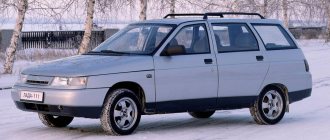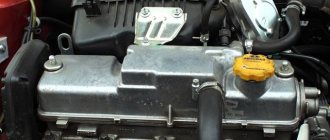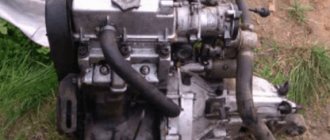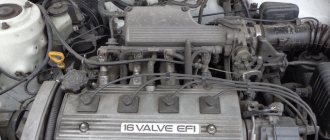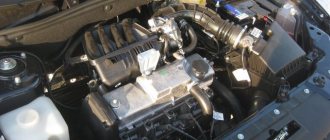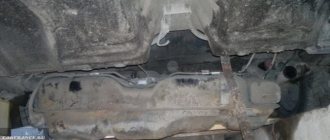Specifications
Before moving directly to the description of the technical characteristics, it is worth noting that all the engines that were installed on the Kalina were produced by AvtoVAZ and the French versions were not installed.
Let's look at the characteristics of the VAZ Kalina engine:
VAZ 21114
| Name | Index |
| Manufacturer | VAZ |
| Volume | 1.6 liter (1598 cc) |
| Number of cylinders | 4 |
| Number of valves | 8 |
| Fuel | Petrol |
| Injection system | Injector |
| Power | 81 hp |
| Fuel consumption | 7.5 l/100 km |
| Cylinder diameter | 82 mm |
| Econorm | Euro-2, Euro-3, Euro-4 |
VAZ 11194
| Name | Index |
| Manufacturer | VAZ |
| Volume | 1.6 liter (1596 cc) |
| Number of cylinders | 4 |
| Number of valves | 16 |
| Fuel | Petrol |
| Injection system | Injector |
| Power | 98 hp |
| Fuel consumption | 7.2 l/100 km |
| Cylinder diameter | 82 mm |
| Econorm | Euro-2, Euro-3, Euro-4 |
VAZ 21126
| Name | Index |
| Manufacturer | VAZ |
| Volume | 14 liter (1390 cm3) |
| Number of cylinders | 4 |
| Number of valves | 16 |
| Fuel | Petrol |
| Injection system | Injector |
| Power | 89 hp |
| Fuel consumption | 7.0 l/100 km |
| Cylinder diameter | 76.5 mm |
| Econorm | Euro-3 |
VAZ 11186
| Name | Index |
| Manufacturer | VAZ |
| Volume | 1.6 liter (1598 cc) |
| Number of cylinders | 4 |
| Number of valves | 8 |
| Fuel | Petrol |
| Injection system | Injector |
| Power | 87 hp |
| Fuel consumption | 7.0 l/100 km |
| Cylinder diameter | 82 mm |
| Econorm | Euro 4 |
VAZ 21127
| Name | Index |
| Manufacturer | VAZ |
| Volume | 1.6 liter (1598 cc) |
| Number of cylinders | 4 |
| Number of valves | 16 |
| Fuel | Petrol |
| Injection system | Injector |
| Power | 106 horses |
| Fuel consumption | 7.0 l/100 km |
| Cylinder diameter | 82 mm |
| Econorm | Euro 4 |
The Lada Kalina engine mainly has an engine capacity of 1.6 liters, with the exception of a 16-valve power unit with a volume of 1.4 liters. Kalina engines were equipped with three types of gearboxes - a 4-speed automatic, a 5-speed manual and a 5-speed robot, which made it possible to use the maximum potential and power of the engine.
Lada Kalina 1.4 VAZ 11184. Reviews - video
Cross section of engine 11194
:
1
- oil pan drain plug;
2
- crankshaft;
3
- oil filter;
4
- catalytic manifold;
5
— coolant pump;
6
- piston;
7
— catalytic manifold gasket;
8
— oxygen concentration sensor;
9
— spark plug;
10
— exhaust valve;
11
— cylinder head;
12
— exhaust camshaft;
13
— camshaft bearing housing;
14
— cylinder head cover;
15
— intake module;
16
— inlet valve;
17
— ignition coil;
18
— hydraulic pusher;
19
— intake camshaft;
20
— nozzle;
22
— diagnostic fitting of the fuel rail;
21
— fuel rail;
23
— cylinder head gasket;
24
— piston rings;
25
piston pin;
26
— cylinder block;
27
fitting of the crankcase ventilation system;
28
— connecting rod;
29
— connecting rod bearings;
30
- flywheel;
31
— oil pan gasket;
32
— oil intake;
33
— engine sump.
Engine maintenance
Maintenance and repair of the Kalina engine is quite simple, since all power units have simple design features. With timely oil changes, the engine life can reach 300,000 km. So, let's consider what and how much oil is needed in the Lada Kalina engine, as well as the replacement process itself.
Changing the engine oil
The process of changing engine oil is quite simple. A minimum amount of tools and time will be required. Let's consider the process of changing engine oil in an engine:
- We place the car on a pit or a lift.
- Remove the negative terminal from the battery.
- Remove the engine crankcase protection.
- Unscrew the drain plug and wait for the oil to run out. Then you need to tighten the drain plug.
- Unscrew the filler neck and pour in engine oil.
- We change the oil filter.
- Fill the required amount, tighten the filler neck and start the engine.
- After the engine has run for 5-7 minutes, check the oil level in the engine.
Many car enthusiasts are wondering how much oil should be poured into Kalina power units. So, according to the service manuals and repair manuals, 3.5 liters of motor fluid fit into the Kalina engine.
The process of changing engine fluid is simple and even a novice car enthusiast can handle it. So, it is worth taking a responsible approach to the issue of choosing oil, since this determines how well and how long the engine will work.
Oil selection
To make a choice of oil, you should refer to the manufacturer's manuals. In most cases, the AvtoVAZ plant fills its cars with Lukyol or RosNeft engine oil.
The majority of Lada Kalina vehicles have semi-synthetic oil in their power unit - 10W-40. But synthetics can also be poured. Let's look at the table of recommended oils for filling into the Lada Kalina engine:
Description of main faults
On Kalina, with regard to power units, there are a number of constant malfunctions. Why are they considered permanent? Most likely, this is due to design flaws that the designers cannot correct. So, let's look at which faults are more common than others.
The engine gets hot
The cause of this phenomenon is often the thermostat. As everyone knows, this is a common occurrence on cars produced by AvtoVAZ, starting with the “Classics”. To eliminate the problem, you need to replace the thermostat with a new one. But what to do if the reason is not in it, and the engine was heating up for another reason? It is worth determining why this is so and what the reasons are.
- Temperature sensor malfunction.
- The cooling fan has failed.
- Faulty wiring or electronic engine control unit.
Failure to comply with the temperature regime can lead to engine malfunction, and will also lead to significant malfunctions of the cylinder head and cylinder block. It is worth remembering that the recommended operating temperature of the Kalina engine is 87-103 degrees Celsius.
To ensure that the car does not heat up above the recommended values, it is necessary to check whether the cooling system and other related components are working properly.
Advantages and disadvantages
The advantage of the 11183 engine is the cylinder head of the original design. However, it was subsequently further modified into the ICE 11186, adding volume to the combustion chambers. The downside is the generator belt tensioner - the drive is constantly over-tightened, a deflection of 10 mm is not ensured without slipping, so the belt life is reduced and it has to be changed more often. This defect was corrected only in the next version of the motor 11186.
The integrated catalytic collector assembly in the engine was initially unfinished:
- the tubes of the four channels are short;
- flows converge inside the block at almost one point;
- exhausts collide and create opposition to each other;
- the shape of the block did not allow changing the arrangement of the tubes.
When installing the engine on the Lada Granta, the cabin heat exchanger was connected to the thermostat in series. All the coolant passed through it along a small circuit, the response temperature error was 5 degrees instead of the required 2 degrees.
Powertrain tuning
Tuning the Lada Kalina engine is carried out by analogy with other power units produced by AvtoVAZ. So, the first thing motorists do is chip tuning. Software settings that allow you to either increase power or reduce consumption. There is also an option to make a balance between two important indicators.
The second option is to overhaul the engine itself and bore it. The power unit is equipped with a lightweight piston group, as well as other tuning parts. Typically, as practice shows, motorists change elements of the cooling and air supply systems.
It is recommended to carry out tuning of the Lada Kalina engine in special studios and services, where professionals can do everything and configure it correctly.
Conclusion
The Lada Kalina engine has several options. Thus, numerous variants of power units were installed on vehicles, which were developed for other models produced by AvtoVAZ. The engine has a simple design and is quite easy to maintain and repair.
The choice of oil for the Kalina engine is a very sensitive issue, since it determines how long and efficiently the main unit of the car will work. Therefore, it is recommended to fill in the fluid recommended by the manufacturer.
Source
What cars was it used in?
The manufacturer AvtoVAZ used engine 11183 to equip several car models:
- Lada Kalina – station wagon, sedan, hatchback;
- Lada Kalina II – second generation in similar bodies;
- Lada Granta – sedan, hatchback;
- 21101 – four-door sedan;
- 21112 – five-door station wagon;
- 21121 – short five-door hatchback;
- 2113 (since 2011) – three-door hatchback;
- 2114 (2006 – 2013) – five-door hatchback;
- 2115 Lada Samara-2 (2007 – 2012) – compact sedan.
Improved engine characteristics ensured the demand for cars of a similar configuration.
About engines for LADA Kalina
A small family of AvtoVAZ cars, Lada Kalina, appeared in 2008 and includes a sedan, station wagon and hatchback. The model was created on the basis of the VAZ 2108 and many units, including engines, were borrowed from it.
Engine VAZ 21114/11183 1.6l (2114 1.6)
The VAZ 21114/11183 power unit became an evolutionary development of the 1.5-liter 2111 engine, but with an oversized cylinder block and an increased piston stroke, due to which the volume of the entire engine increased to 1.6 liters.
The new engine has increased eco-standards, and can also be called reliable and unpretentious, unlike the base 2111. Benefits in terms of traction and elasticity have been noted.
The engine is recognized under several names: 21114, 11183, 2114 and motor-Kalina, but the difference is only in the place of assembly.
The VAZ 21114/11183 four-cylinder in-line injection engine received an overhead camshaft and a timing belt drive.
The lack of hydraulic compensators forces the valves to be periodically adjusted.
If the belt breaks, the valve does not bend; in the sports version of the camshaft there is such a chance.
The disadvantages are generally the same as those of the VAZ 2111, that is, the same noise and diesel engine, tripping, temperature instability, etc. 3
Engine VAZ 11194 1.4 16V
The VAZ 11194 power unit with 16 valves became a simplified version of the Priora engine and an evolution of the VA 21083 in a modified version.
Unlike the base engine, the VAZ 11194 1.4 16V differs in volume, power and worse torque.
The engine life has increased by 50 thousand kilometers compared to its predecessors and reaches 200 thousand km.
In the technical part, the pistons have changed, decreasing in diameter to 76.5 mm, which made it possible to reduce the volume of the engine and combustion chamber. This idea of transformation led to the fact that the torque at the bottom disappeared and the engine starts only from 2000 rpm and requires constant torque.
When the timing belt breaks, the valves bend, the rollers fall apart, and if the pump jams, the timing belt falls off, which leads to expensive repairs.
The VAZ 11194 is not without various noises and knocks, problems with temperature, floating speed and other things. To date, the VAZ 11194 1.4 16V engine has been discontinued. 2
Engine Priora 21126 1.6 16 valves
The 21126 power unit was a continuation of the VAZ 21124, but with a lighter Federal Mogul SPG. The valve wells have become smaller, and the timing belt drive has received an electric tensioner. The cylinder block is surface-finished and honed to Federal Mogul's strict standards.
The 21126 1.6 4-cylinder injection engine received an overhead camshaft and a belt timing mechanism.
The disadvantages of the engine include loss of power, unstable operation and a problematic timing belt. The culprits of such malfunctions are defects in fuel pressure, poor timing, defects in sensors, throttle valve and air pumping with hoses.
When the timing belt breaks, the valves bend.
Loss of performance is detected when compression in the cylinders is low.
Floating speed can be corrected by cleaning the throttle valve or replacing the throttle position sensor.
Noise and knocking are typical for all VAZ engines and the problems lie in hydraulic compensators, connecting rod and main bearings or pistons.
Engine vibrations occur due to defects in high-voltage wires or IAC.
With all its shortcomings, the Priora 21126 1.6 16 valve engine is considered one of the best Russian units for comfortable driving around the city.
Source
Engine VAZ 11183-50
The 183-50 engine was installed on the first Kalina; it was one of the first internal combustion engines with an injector. A huge advantage of this engine is that it does not bend the valve if the timing belt breaks. The engine is equipped with 8 valves, which affects the noise of its operation, as well as a fairly frequent procedure for adjusting the valve clearance.
Specifications
Advantages and disadvantages
- No bending of the valves when the belt breaks;
- Need for valve adjustment
- Low engine power;
- Outdated components;
- Noisy operation;
Engine VAZ 11186
This engine replaced the 11183 internal combustion engine. Distinctive features of this engine are a lightweight cylinder-piston group and connecting rods. Also in the engine, the compression ratio was increased by reducing the recesses for the valves, therefore, this led to bending of the valves when the timing belt breaks.
Specifications
Design Features
After modernizing the 21114 engine taken as a standard, the 11183 engine has the following design nuances:
- “high” cylinder block – height increased by 2.3 mm compared to 2110;
- fasteners - the holes are threaded with M12 standard pitch;
- crankshaft – original, steel, forged, crank radius increased by 2.3 mm;
- cylinder head gasket – thickness 1.2 mm, regular;
- combustion chamber – increased to 26 cm 3 due to two-stage milling;
- catcollector - short tubes, round block shape.
To reduce manufacturing costs, a connecting rod-piston group, a pulley and a crankshaft flywheel from the 2110 engine are installed in the engine. The volumes of the combustion chambers are increased for the engine with the sole purpose of ensuring a compression ratio of 9.6 - 10.0.
The manufacturer does not provide hydraulic compensators in this internal combustion engine, therefore, on the one hand, the use of lower quality oil is allowed. On the other hand, the savings in the operating budget when using cheap lubricants are “eaten up” by the costs of periodically adjusting the valves in a service station, since the manufacturer recommends doing it more often.
The main attachments are driven by their own belts. The design of tensioners (for example, a generator) leaves much to be desired. But the internal combustion engine allows you to increase power in the following ways. Moreover, a reasonable boost does not require major repairs to be carried out more often than the established deadline.
Even without improving the performance, the engine is high-torque and torquey, and produces 200% of the service life declared by the manufacturer. The available repair dimensions of the piston group make it possible to increase the service life, taking into account several overhauls, up to a million kilometers.

